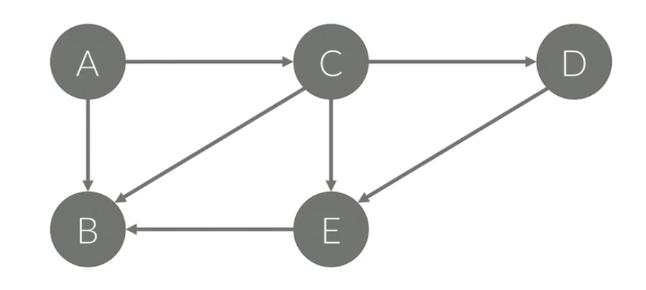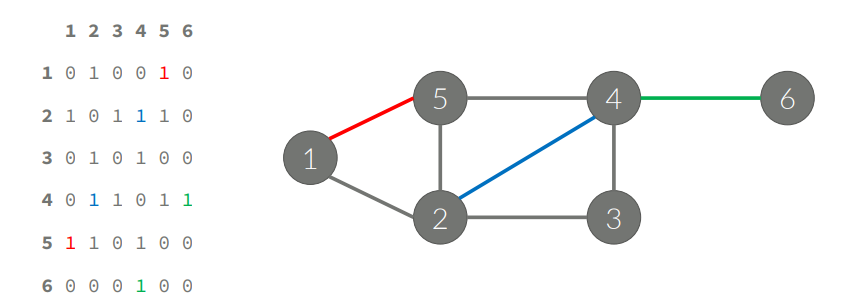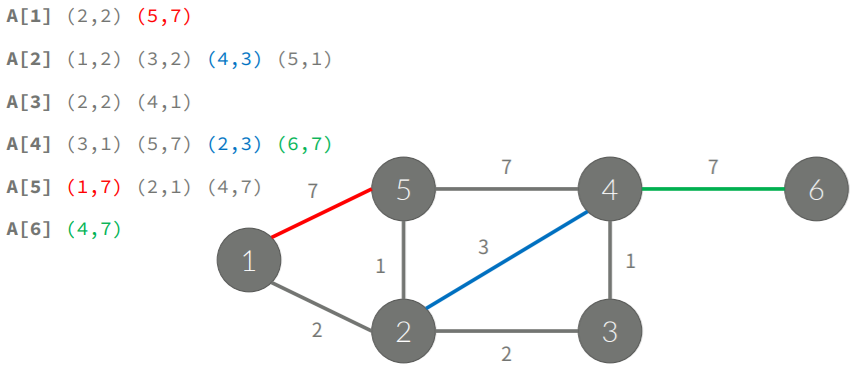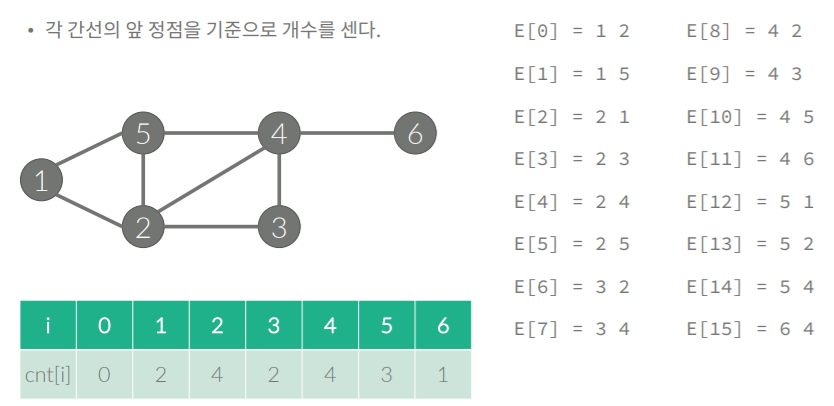https://webnautes.tistory.com/1158
vscode C++ 환경에 맞추어 PS하기
그래프
그래프 알고리즘은 문제에 나와 있는 상황을 그래프로 모델링한 다음에 여러가지 알고리즘을 수행하게 된다.
그래프 문제 알고리즘은 동일하다.
단지 데이터를 어떻게 그래프로 만들지가 중요하다.
용어
-
정점(Node, Vertex)
-
간선(Edge) : 정점간의 관계를 나타낸다.
-
경로 : 정점간의 이동에 대한 간선의 연속을 의미한다.

-
사이클 : 시작 정점과 도착 정점이 같은 것을 이야기 한다.
-
단순 경로, 단순 사이클 : 경로/사이클에서 같은 정점을 두 번 이상 방문하지 않는 경로/사이클
※ 특별한 일이 없다면 단순 경로/사이클을 의미
- 방향 그래프, 무방향 그래프 : 보통 무방향도 방향 그래프로 바꾸어 저장함. - 그래서 무방향 그래프를 양방향 그래프라고 부르기도 함
※ 만약 간선이 두개이면 두 간선을 서로 다른 간선으로 취급
- 루프 : 간선의 양 끝 점이 같은 경우
- 가중치(중요) : 간선에 적힌 값 - 거리, 시간, 비용으로 만약 적혀있지 않다면 가중치는 1로 보면 됨
- 차수 : 정점과 연결된 간선의 갯수 ( Degree - 방향 : In-degree 들어오는 간선 / Out-degree 나가는 간선)
그래프의 표현
효율의 차이로 인접 행렬과 리스트의 차이를 생각해야 하다. 한 정점 X와 연결된 간선을 효율적으로 찾는 구조.
효율이라는 것은 한정점 X와 연결된 간선을 효율적으로 찾는 것을 이야기 한다.
- 인접 행렬 :
V x V의 이차원 행렬 : 가중치 넣을 수 있음. 공간 v^2필요, 한 정점과 연결된 모든 간선을 구하는 시간 - O(v)

- 공간 복잡도 : O(V^2)
- 시간 복잡도 : O(V)
인접 행렬은 두 정점 사이에 간선이 있는지 없는지만 확인함, 그래서 잘 안씀
- 인접 리스트
연결되어 있는 정점을 모두 리스트 안에 집어넣음

만약 가중치가 존재한다면 같이 묶어서 저장해 주면 됨 사용하는건 링크드 리스트나 길이를 동적으로 변경할 수 있는 배열을 사용
-
C++ :
vector<int> a[1001] -
Java : Array List
-
Python : [] - 리스트 형태인데 append() 함수때문에 가능
-
공간복잡도 O(E)
-
시간복잡도 O(차수)
인접리스트가 더 적은 공간과 더 적은 시간 사용
- 간선 리스트
-
인접 행렬과 인접 리스트 모두 싫을 때 사용 => 대중적인 자료구조는 아님
-
배열을 이용해 모든 간선 정보 저장

-
누적의 방식으로 나중에는 배열에 각 노드별 간선 정보를 저장한 칸의 시작위치를 저장 그리고 누적의 방식으로 값을 더해 나아가면 각 정점의 시작 위치를 알 수 있음
-
시간복잡도 : O(차수)
정리하면 다음과 같이 선언하면 된다.
-
인접행령
bool a[2000][2000] -
인접리스트
vector< int > g[2000]; -
간선리스트
vector< pair < int, int >> edges;
문제
13023 ABCDE(대표)
N명의 친구 관계에서 주어진 것과 같은 친구 관계가 존재하는지 알아보는 문제로 세가지의 케이스로 데이터를 모두 저장하여서 사용하게 된다.
- 인접행렬
- 인접 리스트
- 간선 리스트
친구 관계 = 간선으로 구현
A->B, C->D
이때 B->C로 가는걸 찾기 위해 인접행렬을 사용해야 한다.
D->E로 가는 인접리스트를 사용해주면된다.
이때 코드 중간에 m을 두배로 만드는데 이것은 간선의 갯수는 각각 두개씩 넣어주었기 때문에 두배를 해준것이다.
import sys
sys.stdin=open("input.txt","r")
m=0
n=0
n,m=map(int,input().split())
# 인접행렬
a=[[False]*n for _ in range(n)]
# 인접리스트
g=[[] for _ in range(n)]
# 간선리스트
edges=[]
for i in range(m):
f,t=map(int,input().split())
a[f][t]=a[t][f]=True
edges.append((f,t))
edges.append((t,f))
g[f].append(t)
g[t].append(f)
m*=2
for i in range(m):
for j in range(m):
A,B=edges[i]
C,D=edges[j]
if A==B or A==C or A==D or B==C or B==D or C==D: continue
if not a[B][C]: continue
for E in g[D]:
if E==A or E==B or E==C or E==D: continue
print(1)
sys.exit(1)
print(0)코드는 인접행렬 인접리스트 간선리스트를 모두 사용된 형태로 짜여지기는 하였지만 실재로 이렇게 구현하지 않아도 위의 문제를 푸는데 문제는 없다.
#include <iostream>
#include <algorithm>
#include <vector>
#include <cmath>
#include <map>
#define ll long long
using namespace std;
bool a[2000][2000];
vector<int> g[2000];
vector<pair<int,int> > edges;
int main(void)
{
freopen("input.txt", "r", stdin);
ios_base::sync_with_stdio(false);
cin.tie(nullptr);
cout.tie(nullptr);
int n,m;
cin>>n>>m;
for(int i = 0 ; i < m ; ++i)
{
int from, to;
cin>>from>>to;
edges.push_back({from,to});
edges.push_back({to,from});
a[from][to] = true;
a[to][from] = true;
g[from].push_back(to);
g[to].push_back(from);
}
m *= 2;
for(int i = 0 ; i < m; ++i)
{
for(int j = 0 ; j < m ; ++j)
{
int A = edges[i].first;
int B = edges[i].second;
int C = edges[j].first;
int D = edges[j].second;
if(A==B || A == C || A == D || B == C || B == D || C == D)
continue;
if(!a[B][C])
continue;
for(auto E = g[D].begin(); E != g[D].end(); ++E)
{
if(*E == A || *E == B || *E == C || *E == D)
continue;
cout<<"1"<<'\n';
return (0);
}
}
}
cout<<"0"<<'\n';
return (0);
}그래프의 탐색
DFS와 BFS가 존재
void dfs(int node) {
check[node] = true;
cout << node << ' ';
for (i = 0; i < a[node].size(); ++i) {
int next = a[node][i];
if (check[next] == false) {
dfs(next);
}
}
}
void bfs(int node) {
queue<int> q;
memset(check, false, sizeof(check));
check[node] = true;
q.push(s);
while (!q.empty()) {
int now = q.front();
q.pop();
cout << now << ' ';
for (i = 0; i < a[now].size(); ++i) {
int next = a[now][i];
if (check[next]==false) {
check[next] = true;
q.push(next);
}
}
}
}문제
1260 DFS와 BFS
#define _CRT_SECURE_NO_WARNINGS
#define _USE_MATH_DEFINES
#include <iostream>
#include <algorithm>
#include <string>
#include <cstring>
#include <cstdio>
#include <functional>
#include <cstdlib>
#include <vector>
#include <ctime>
#include <cmath>
#include <stack>
#include <queue>
#define ll long long
#define len 1001
using namespace std;
int ans, i, j, n, m,s;
vector<int> a[1001];
bool check[1001];
void dfs(int node) {
check[node] = true;
printf("%d ", node);
for (int i = 0; i < a[node].size(); i++) {
int next = a[node][i];
if (check[next] == false) {
dfs(next);
}
}
}
void bfs(int start) {
queue<int> q;
memset(check, false, sizeof(check));
check[start] = true;
q.push(start);
while (!q.empty()) {
int node = q.front();
q.pop();
printf("%d ", node);
for (int i = 0; i < a[node].size(); i++) {
int next = a[node][i];
if (check[next] == false) {
check[next] = true;
q.push(next);
}
}
}
}
int main() {
int n, m, start;
scanf("%d %d %d", &n, &m, &start);
for (int i = 0; i < m; i++) {
int u, v;
scanf("%d %d", &u, &v);
a[u].push_back(v);
a[v].push_back(u);
}
for (int i = 1; i <= n; i++) {
sort(a[i].begin(), a[i].end());
}
dfs(start);
puts("");
bfs(start);
puts("");
return 0;
}2667 단지번호 붙이기
- 그래프 같지 않은 문제를 그래프로 바꾸어 푸는 예시
- 4방향에 대해 BFS 를 수행하면 풀기 때문에 어렵지 않게 풀 수 있음
#define _CRT_SECURE_NO_WARNINGS
#include <iostream>
#include <vector>
#include <algorithm>
#include <queue>
#define ll long long
using namespace std;
int a[30][30];
int check[30][30];
int dx[4] = { 0,0,-1,1 };
int dy[4] = { -1,1,0,0 };
int n;
int cnt[25*25] = { 0 };
void bfs(pair<int, int> x,int ans) {
queue<pair<int, int>>q;
q.push(x);
check[x.first][x.second] = ans;
while (!q.empty()) {
pair<int, int> cur = q.front();
q.pop();
for (int i = 0; i < 4; ++i) {
pair<int,int> next = {cur.first+dx[i],cur.second+dy[i]};
if (0 <= next.first && next.first < n
&& 0 <= next.second && next.second < n) {
if (a[next.first][next.second] == 1
&& check[next.first][next.second] == 0) {
q.push(next);
check[next.first][next.second] = ans;
}
}
}
}
}
int main(void) {
//freopen("input.txt", "r", stdin);
int t;
cin >> n;
for (int i = 0; i < n; ++i) {
for (int j = 0; j < n; ++j) {
scanf("%1d", &a[i][j]);
}
}
int ans=0;
for (int i = 0; i < n; ++i) {
for (int j = 0; j < n; ++j) {
if (a[i][j] == 1 && check[i][j] ==0) {
bfs(make_pair(i, j), ++ans);
}
}
}
cout << ans<<endl;
for (int i = 0; i < n; ++i) {
for (int j = 0; j < n; ++j) {
cnt[check[i][j]] += 1;
}
}
sort(cnt+1, cnt+ ans+1);
for (int i = 1; i <= ans; ++i) {
cout << cnt[i] << endl;
}
return 0;
}
4963 섬의 갯수
- 비슷하게 bfs를 사용하지만 8방향 즉 대각선까지 사용하면 되기 때문에 조금만 응용해서 풀면 됨
#define _CRT_SECURE_NO_WARNINGS
#include <iostream>
#include <vector>
#include <algorithm>
#include <queue>
#define ll long long
using namespace std;
int a[51][51];
int check[51][51];
int dx[8] = { -1,0,1,1,1,0,-1,-1 };
int dy[8] = { -1,-1,-1,0,1,1,1,0 };
int n,m;
//int cnt[50*50] = { 0 };
void bfs(pair<int, int> x,int ans) {
queue<pair<int, int>>q;
q.push(x);
check[x.first][x.second] = ans;
while (!q.empty()) {
pair<int, int> cur = q.front();
q.pop();
for (int i = 0; i < 8; ++i) {
pair<int, int> next = {cur.first+dx[i],cur.second+dy[i]};
if (0 <= next.first && next.first < m
&& 0 <= next.second && next.second < n) {
if (a[next.first][next.second] == 1
&& check[next.first][next.second] == 0) {
q.push(next);
check[next.first][next.second] = ans;
}
}
}
}
}
int main(void) {
freopen("input.txt", "r", stdin);
//m:y, n:x
while (1) {
scanf("%d %d", &n, &m);
if (n == 0 && m == 0) break;
for (int i = 0; i < m; ++i) {
for (int j = 0; j < n; ++j) {
scanf("%1d", &a[i][j]);
check[i][j] = 0;
}
}
int ans = 0;
for (int i = 0; i < m; ++i) {
for (int j = 0; j < n; ++j) {
if (a[i][j] == 1 && check[i][j] == 0) {
bfs(make_pair(i, j), ++ans);
}
}
}
printf("%d\n", ans);
}
return 0;
}2178 미로 탐색
-
DFS는 사용 불가 -> 탐색이 완전 랜덤이라서 최소를 찾아내는 문제에는 좋지 못함
-
BFS의 단계별 풀이를 이용하여야 함

-
이와 같이 한 칸 간 것을 한 단계 간걸로 생각해 볼 수 있기 때문에 BFS는 단계별 풀이가 가능

